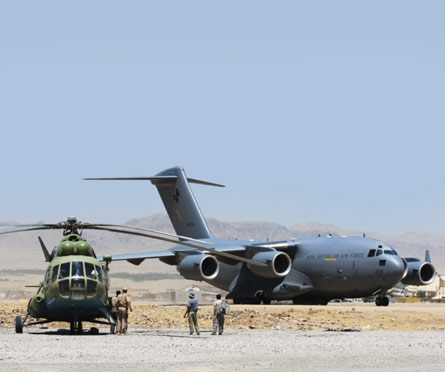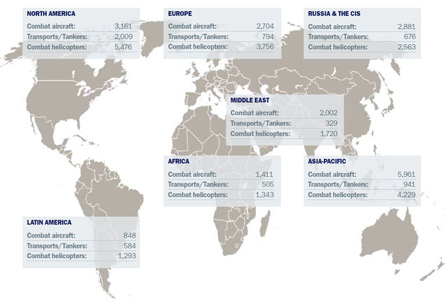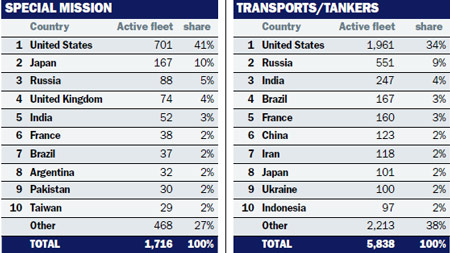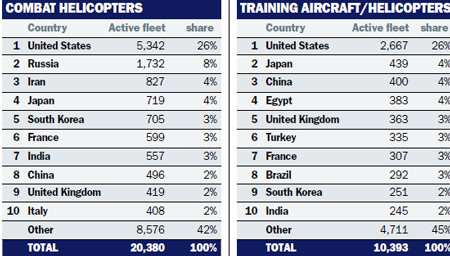While the global economic downturn has had an adverse effect on military procurement plans in some parts of the world, operational imperatives have, in most cases, seen nations go ahead with planned major acquisitions.
This year has seen the first confirmed international orders for Lockheed Martin's F-35 Joint Strike Fighter - from Australia, the Netherlands and the UK. The type appears set to dominate the combat aircraft sector in coming years, with over 3,000 more planned to be sold to the programme's partner nations.
 |
|---|
© Australian Department of DefenceOperations in Afghanistan prompted Canberra to buy the C-17, while the host country has recently acquired new Mi-17 helicopters |
Demand for new transports, combat helicopters and special-mission aircraft is also high, prompted for many nations by the need to support NATO-led operations in the harsh environment of Afghanistan, which provides a tough test for legacy equipment now in service.
 |
|---|
Click for larger image |
Flightglobal's World Air Forces directory (See MiliCAS & HeliCAS) this year lists more than 58,000 military aircraft in the active inventories of almost 160 nations, and details confirmed and planned orders for over 11,000 more.
The US armed services account for the largest national share of the global military fleet in all categories, having more than three times the number of active aircraft than second-placed Russia, and an overall share of 24%.
The series of tables below show the worldwide active fleet share per country:



But with the next three places in our top 10 being held by China, India and Japan, Asia's combined military strength totals almost twice the number of combat aircraft that North America has - almost 6,000 platforms.
With the fewest combat aircraft in current use, Latin America's largest near-term fighter requirement - Brazil's initially 36-aircraft FX-2 deal - had yet to be concluded as this directory was published. Although a selection could slip into 2010, Dassault appears to have stolen a march with its Rafale in the battle against the Boeing F/A-18E/F Super Hornet and Saab's Gripen NG.
All three types remain in contention for India's longer-term medium multirole combat aircraft requirement, facing the Eurofighter Typhoon, Lockheed F-16 and RSK MiG-35 in pursuing the programme for at least 126 aircraft. In-country evaluations will continue through the middle of next year, but a selection will not be made in a hurry.
Meanwhile, war-affected countries such as Afghanistan and Iraq are striving to establish credible air wings after years of conflict. Kabul has received its first two modernised Alenia Aeronautica G222 transports during 2009, plus its first new Mil Mi-17 transport helicopters for many years. Its wider aspirations include a future lightweight fighter buy, which would support its ability to ensure stability as coalition forces eventually reduce their presence in Afghanistan.
Iraq's post-Saddam Hussein-era air force also continues to grow, with two Beechcraft T-6A trainers having just been delivered, and recent requests made for new fleets of light and medium utility helicopters.
| Worldwide top 10 active aircraft types
|
|---|
Click for larger image |
Although financial turmoil has reached even the previously unruffled Gulf and embarrassed Dubai, the region remains a key target for Western manufacturers, as it looks to grow beyond the roughly 4,000 military aircraft now in use.
Recent orders have included sales of the Typhoon fighter, Boeing C-17 and Lockheed C-130J transports, Alenia Aermacchi M-346 and Pilatus PC-21 trainers, and Saab's 340-based airborne early warning and control aircraft, and more deals will follow.
Times may be tough, but in the military sector, nations that fail to invest adequately in new aircraft and equipment risk falling rapidly behind their potential future adversaries - a risk few major countries are willing to run.
EXPLANTORY NOTES:
Flightglobal's World Air Forces directory uses fleet data compiled from its MiliCAS and HeliCAS databases by Nick Fulleylove, Sandra Lewis-Rice, Martin Smith and Jon Underdown, and abridged by Craig Hoyle.
Published as premium products, MiliCAS and HeliCAS give subscribers detailed fleet and orders information, in most cases down to serial-number detail.
For the first time, this year's directory also includes fleet analysis, provided by Antoine Fafard from Flightglobal's Insight team. Responsible for publishing special reports on the aviation industry, Insight provides bespoke analysis on sectors such as business aviation, and commercial and military aircraft.
Fleet information is divided into these categories:
Active: Aircraft in day-to-day use. For Soviet-era types where only summary information is available, this also includes some non-operational platforms.
Ordered: Aircraft on firm order. Others that are pending purchase approval or contract signature are marked with an asterisk. This category includes current planned order totals for models such as the Lockheed Martin F-35 Joint Strike Fighter, which may be subject to future revision.
Abbreviations
AEW airborne early warning; Comms communications; ELINT electronic intelligence; EW electronic warfare; MPA maritime patrol aircraft; Recce reconnaissance; SAR search and rescue; SIGINT signals intelligence.
Source: Flight International
























